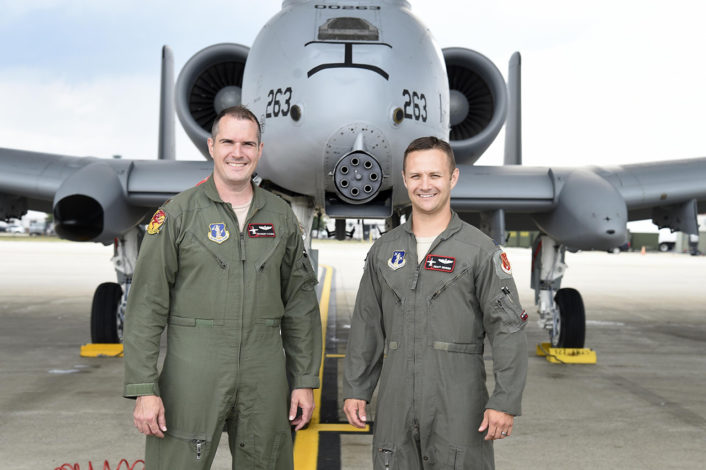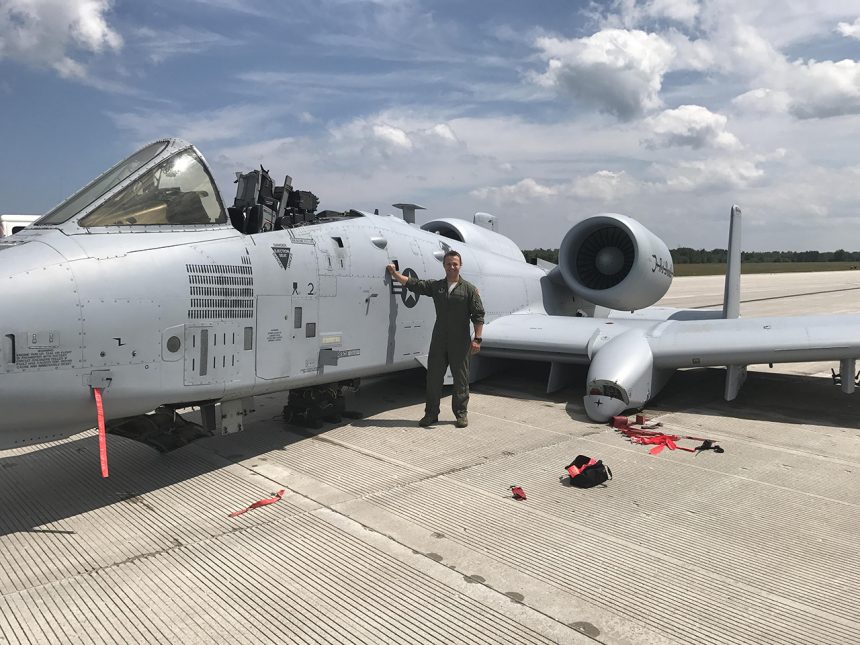Any landing you can walk away from is a good landing.
The A-10 is famous for being exceptionally tough and able to survive direct hits from armor-piercing and high-explosive projectiles. A recent episode proves the Warthog’s durability combined with pilot training, can be extremely useful, when it deals with managing an unusual emergency.
On Jul. 20, Capt. Brett DeVries, who was flying his A-10 Thunderbolt II aircraft over the forests of Alpena County, in northeast Michigan, was able to land on the runway at the Alpena Combat Readiness Training Center with his aircraft whose canopy had blown off the aircraft 25 minutes before, whose main radio had stopped working, along with the first back-up, and with the landing gear that would not come down.
According to the U.S. Air Force, the 107th Fighter Squadron pilot from Selfridge Air National Guard Base made something that was never achieved before in the roughly 40-year history of the A-10: indeed, DeVries was the first pilot to land with no canopy and with the landing gear up.
“In that moment, your training kicks in. The training – that’s what saves you and your wingman,” DeVries said in an official release that provides all the details you can find in this story.
He was part of a four-ship on a routine training sortie from Selfridge to the Grayling Air Gunnery Range: a pretty standard mission for DeVries and his peers in the 107th, known as the “Red Devils,” that included a 30-minute transit to Grayling, to drop dummy bombs and make several strafing passes with the 30mm GAU-8 Avenger Gatling-style gun. A type of sortie DeVries has flown some 300 times!
After performing six bomb passes over the gunnery range to drop their ordinance, each A-10 took a turn firing the 30mm gun. However, on his second pass, DeVries’ gun malfunctioned. Simultaneously, the canopy of his aircraft blew off. With the canopy off and flying at about 325 knots, the wind caught in his helmet and slammed DeVries’ head back into the seat.
“It was like someone sucker punched me,” he said. “I was just dazed for a moment.”
At the time, he was flying at about 150 feet. DeVries instinctively pulled back on his stick to gain altitude and climbed to 2,000 feet, out of the normal path for range traffic, to put some space between his aircraft and the ground.
Flying behind DeVries was Major Shannon Vickers, another 107th pilot.
He saw a “donut of gas” from the Avenger gun around Devries’ aircraft, but didn’t realize the canopy had blown off because he was focused on the ground targets in the range. Still, he thought that something was wrong when the A-10 ahead of him had suddenly climbed.
Inside his cockpit, DeVries operated on instinct: he first lowered the seat in the cockpit to try to escape the winds that were buffeting his head back and forth and causing his maps and checklists to be blowing all around.
Another issue the pilot had to assess was the integrity of the ejection seat: had the blown canopy compromised it?
Vickers flew under him, performing a visual inspection of the damaged aircraft.
In addition to having been an A-10 pilot for the past 10 years, Vickers brought a little extra knowledge to the table. The Michigan native started his military career as an enlisted weapons specialist, working on A-10s at the 110th Attack Wing in Battle Creek.
Quickly, the two Red Devils determined that the best plan would be to fly over to Alpena, just a few minutes away by air, and attempt a landing there. While flying there, the Alpena control tower called down to Selfridge, some 250 miles to the south, in metropolitan Detroit. Soon, several A-10 maintenance specialists were on a speaker phone, chiming in with their ideas and recommendations, which Alpena then relayed to Vickers and DeVries, who was now down to using his third-best radio system.
Finally, with Vickers chasing him, the pilot of the damaged Warthog tried to lower his landing gear: the gear started to come down, but, as they feared, the nose gear was hung up from the gun damage.
Quickly, Vickers radioed to DeVries: “Gear up!”
Fortunately, the gear completely retracted to the up position.
With no other option remaining, with gear up and the canopy off DeVries lined the aircraft up for a landing.
“As he made final approach, I felt confident he was making the right decision,” Vickers said. “We had talked through every possibility and now he was going to land it.”
Shallow approach. Not too fast. Minimal flare.
On the A-10, the two main landing gear wheels are exposed, even when in the up position. It is part of the combat resiliency of the aircraft. And so, Capt. Brett DeVries landing his ‘Hog, right in the middle of the runway in a near textbook landing – caught on video by another pilot who was on the ground at Alpena.
“I flew him down, calling out his altitude,” Vickers said. “He came in flat, I mean it was a very smooth landing.”
After flying alongside DeVries during the landing, Vickers circled the field and saw his fellow Red Devil exit the aircraft on his own and run to the fire truck; then he was instructed to return to Selfridge.
“There is a reason why we train as a two-ship or greater,” said Col. Shawn Holtz, Commander of the 127th Operations Group and an A-10 pilot. “We rely on each other and need to have mutual support within the flight. Maj. Vickers was the definition of what a Wingman should be in this flight. He stuck with Capt. Devries and did everything in his power to see this through to a safe landing. Both of these pilots demonstrated not only superior flying skills, but represent the type of teamwork and professionalism that should be the goal of every Attack Pilot.”
In all, the flight lasted about 25 minutes from the time the canopy blew off until landing. An investigation is underway into the cause of the original malf The A-10 is still at Alpena where it is being repaired and will return to the flying inventory at Selfridge
“Again, I want to stress the training,” DeVries said. “Sometimes, perhaps we think, ‘Why do we have to do this training again and again?’ Well, in this case, the training took over and it is what made the difference.”
Slocum said the two men will be submitted for appropriate recognition for their superior Airmanship during the July 20 flight. DeVries also received an email congratulating him from Gen. David L. Goldfein, the Air Force Chief of Staff.










